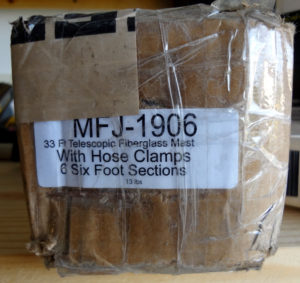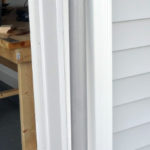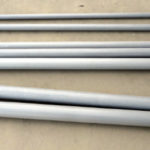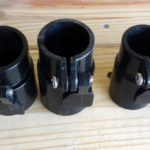Ordered an MFJ-1906 fiberglass mast from DX Engineering over the weekend and it arrived at the house yesterday.
I ordered the 33′ hose clamp version of the mast, but what ended up at the house was the 38′ quick clamp version (MFJ-1906HD). Even the label on box said it was the hose clamp version. Factory labeling error I guess. Can’t really fault DX Engineering for sending the wrong item.
Instead of the expected six 6′ sections of fiberglass tubing inside the box, there were seven 6′ fiberglass tubes along with 6 quick clamps. It’s a pretty compact package. One 6′ x 2.5″ OD tube with all the others nested inside.
The quick clamps need to be glued to each mast segment so that they don’t come off while you’re extending each segment. The only suitable glue I had was epoxy, so I just used that.
Final assembly is just a matter of adjusting the quick clamps so that the tubes slide into each other and holds securely when the clamp lever is in the down position. I marked the bottom end of each tube at 12 cm (the instructions suggest marking them at 1 ft (~30 cm) as an indicator to stop pulling each tube out.
Final length is just over 2.1 m (7′) and fully extended (leaving about 12 cm nested inside the previous segment) the mast is about 12.2 m (40′) long. Leaving about 30 cm nested in each segment would bring the total length down to just over 11 m (37′), which is still plenty long enough for my purposes. Probably a good idea to leave the thinnest tube nested a little further inside for extra strength, especially on a breezy day.
The mast seems pretty sturdy, although I can tell that getting it up is going to be at least a two person job. At somewhere around 10 kg (~20ish lbs), the mast doesn’t weight a whole lot, but the length can make it bulky and unwieldy. The quick clamps should easily hold each segment well enough for the mast to support a wire or other light weight antenna.
The quick clamps seem like they’ll need readjusting, especially if they’re being locked/unlocked frequently. Don’t drag it on the ground while you’re carrying it around, especially on hard surfaces or you’ll end up grinding away the mast.
Now to figure out how to secure the dipole to the top of the mast.
8/10 stars. (10/10 for value in my case).







